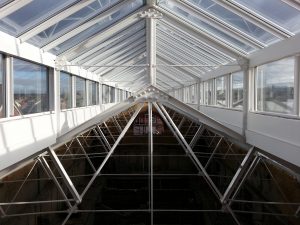MANAGING SOLAR GAINS
It would be reasonable to assume that an increase in glazing in new dwellings and buildings would improve the amount of natural light entering the space. The challenge arises when the need for managing solar gains in the summer are factored in.
Combating Solar Gains
The current Part L1A (Conservation of Fuel and Power in New Dwellings) addresses limiting the effects of solar gains in summer. ‘Solar gains are beneficial in winter to offset demand for heating, but can contribute to overheating in summer. The effects of solar gain in summer can be limited by an appropriate combination of window size and orientation, solar protection through shading and other solar control measures, ventilation (day and night) and high thermal capacity.’
Part L1A
Part L1A also recognises, when seeking to limit solar gains, ‘…consideration should be given to provision of adequate levels of daylight.’ Yet, Building Regulations in England do not specify a minimum daylight requirement. Instead, the BS 8206-2 Code of Practice for Daylighting recognises that good lighting goes beyond achieving minimum illumination for task performance
It’s fair to say, it’s a balancing act.
Balancing Performance & Light
Reducing the window area of a new dwelling is one of the suggestions for limiting solar gains in summer yet it has ‘…conflicting impacts on the predicted CO2 emissions: reduced solar gain but increased use of electric lighting. As a general guide, if the area of glazing is much less than 20 per cent of the total floor area, some parts of the dwelling may experience poor levels of daylight, resulting in increased use of electric lighting.’
With Part L focussed on lighting methods and delivering efficiencies through design, it would be easy to think that new build homes across the UK are in a no-win situation – having to compromise on the number and size of windows (glazed areas) in order to limit solar gain while still providing a happy, healthy living space.
Letting in around twice as much light than vertical glazing, and up to three times as much as dormer windows, rooflights are a popular solution.
Let there be Light
The National Association of Rooflight Manufacturers (NARM) states that ‘…the glazing is pointing directly at the light source with very little diffused or reflected light. Consequently, rooflights and roof windows can supply a great deal more daylight into the heart of the home thereby illuminating areas that might otherwise be quite dark.’
Making a room feel bright and airy, rooflights can help cut the cost of energy bills by reducing the demand for electric lighting. And of course, the greater the rooflight area, the greater the potential savings.
NARM reports that ‘ the amount of energy needed to light a building artificially is often much greater than the amount of energy used to heat it, and is often the greatest single energy use in operating the building.’ The impact is both financial and environmental with ‘…electricity used for lighting being more expensive in terms of CO2 than gas used for heating.
Rooflights are particularly beneficial when designing a new build extension where the vertical windows have been removed. Rooflights allow daylight to penetrate further into the building, illuminating areas that would otherwise be gloomy.
When addressing solar gains, the location and orientation of the dwelling must be considered during the planning stage, to assess the shading benefits of neighbouring buildings and trees. This will also help determine the best position for the rooflight.
Glazing Options
Many rooflight manufacturers combat the issue of solar gains through high performance glazing, with suppliers offering a wide variety of glass options including coated and uncoated. Solar control glass, for example, can help retain heat in cooler months, with a leading glass manufacturer achieving a thermal insulation U-value of 1.0 Wm2K.
While coatings can sometimes change the colour inside the building, there are options which are neutral in appearance and have low internal reflection. Both of these factors help to give a clearer view to the outside.
Self-cleaning glass is now widely specified and is a popular choice for vertical and roof windows, conservatories and rooflights. A unique coating breaks down the organic matter and even works on cloudy days and at night. Some glass manufacturers also combine self-cleaning properties with solar control performance.
Benefit from Experienced Rooflight Manufacturers
All too often, rooflights are ordered within a few clicks but the UK rooflight industry has so much more to offer than a quick-buy on the internet. With several rooflight companies starting as early as the mid-sixties and seventies, there’s a lot be gained from working with an established rooflight expert, not least the experience and knowledge to help realise the benefits of natural light in the built environment.

